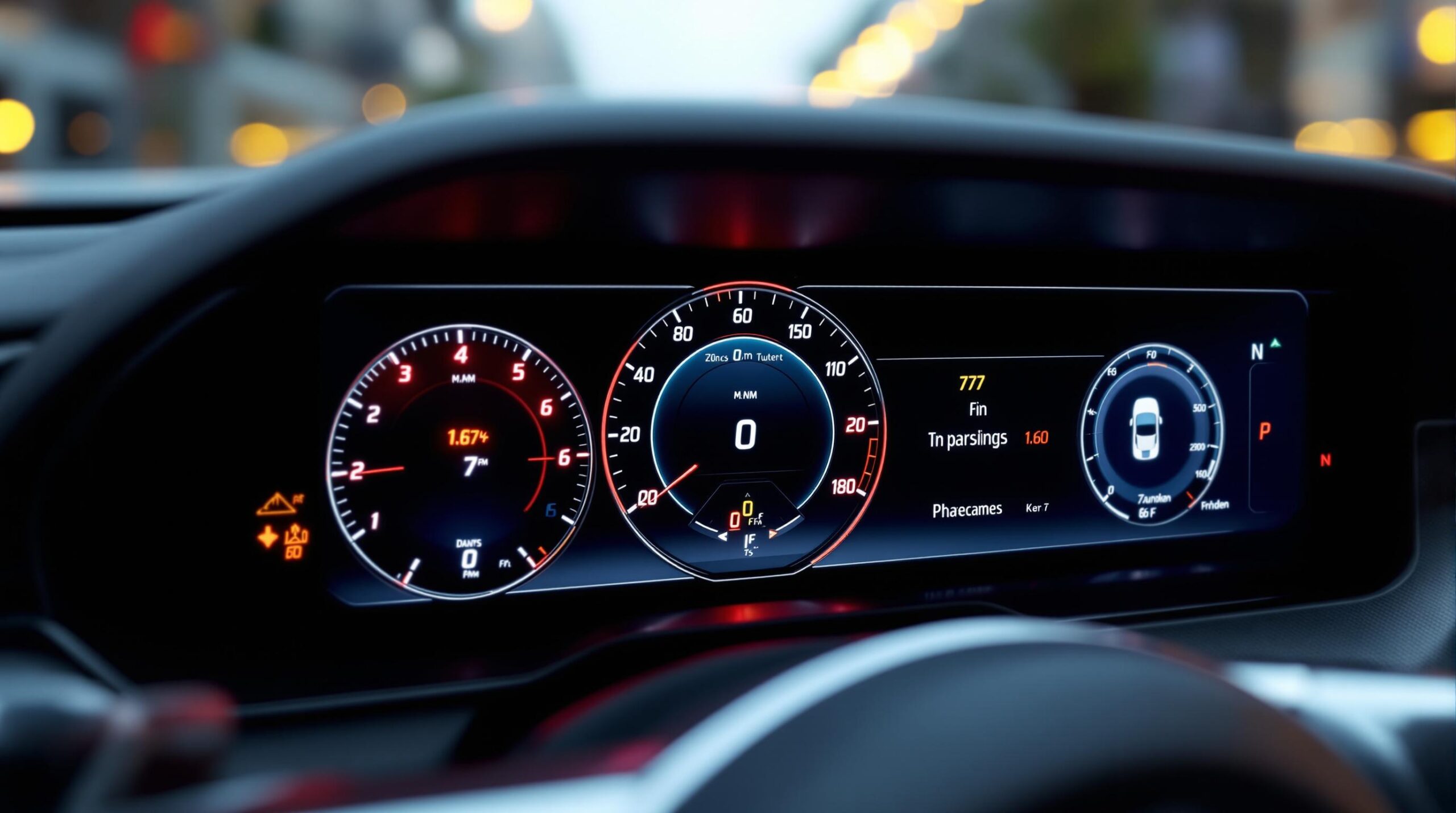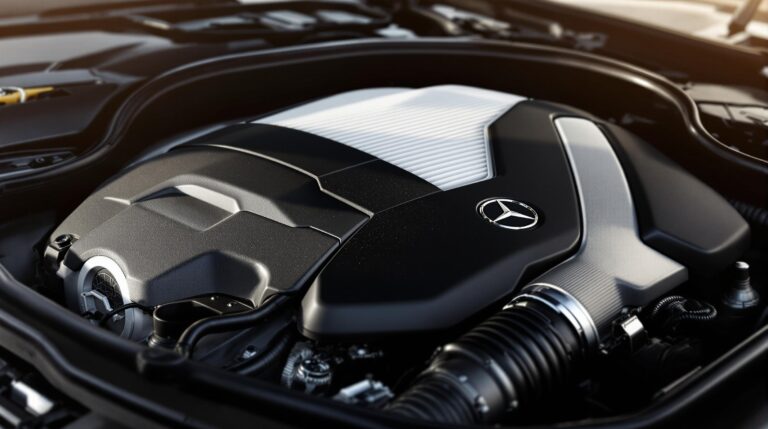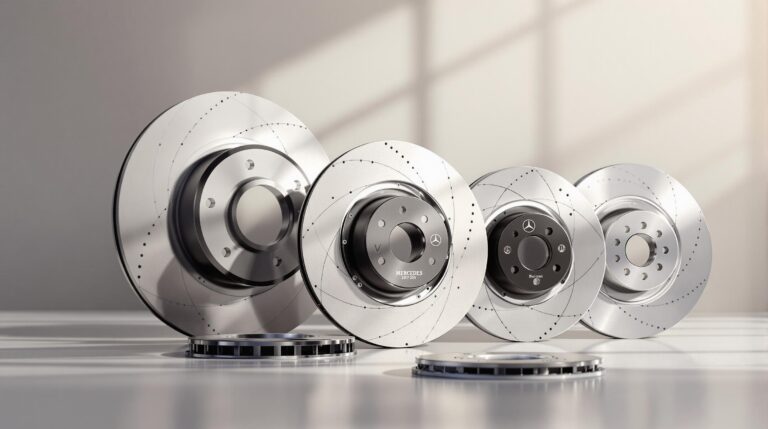10 Common Mercedes Warning Lights Explained
Your Mercedes dashboard lights are more than just symbols – they’re your car’s way of communicating. Here’s a quick breakdown:
- Green/Blue Lights: System is working normally. No action needed.
- Yellow/Orange Lights: A non-urgent issue. Plan a service soon.
- Red Lights: Critical problem. Stop immediately and seek help.
Quick Overview of Warning Lights:
- Check Engine Light: Signals engine issues, from a loose gas cap to serious faults.
- Brake Warning Light: Indicates issues like low brake fluid or ABS problems.
- ABS Light: Alerts to anti-lock braking system faults.
- Battery Light: Points to electrical issues like a failing alternator.
- Oil Pressure Light: Warns of dangerously low oil pressure.
- Engine Temperature Light: Signals overheating – stop immediately.
- Tire Pressure Light: Low tire pressure or sensor issues.
- Airbag Light: Indicates a fault in the airbag system.
- ESP/Traction Light: Stability control system issues.
- AdBlue Light: For diesel cars, warns of low AdBlue levels or system faults.
Key Takeaway:
Red lights mean immediate action is required to avoid damage or safety risks. Yellow lights need attention soon. Regular maintenance can help prevent these warnings from appearing. Always consult your owner’s manual or a professional for further guidance.
Mercedes Warning Lights Explained – Meaning and How to Fix
What Mercedes Warning Lights Tell You
Mercedes-Benz warning lights act as an early alert system, with sensors constantly monitoring your vehicle to flag potential issues. These indicators help you stay informed about your car’s health and safety, making it easier to address problems before they worsen.
Here’s how it works: sensors pick up irregularities, and the onboard computer activates the appropriate warning light.
| Warning Light Color | Meaning | Action Needed |
|---|---|---|
| Green/Blue | System is active or functioning as expected | No action needed – keep driving |
| Yellow/Orange | Non-urgent issue detected | Plan a service appointment soon |
| Red | Critical problem detected | Pull over safely and address immediately |
This color-coded system is straightforward and backed by industry professionals:
"Mercedes dashboard symbols help drivers stay safe on the road by letting them know that something needs attention. Not all symbols are universal. If you are unsure, please refer to your owner’s manual or contact your dealer."
The system’s real advantage? It gives you a heads-up about problems early on, reducing the risk of costly repairs down the line.
Key things to keep in mind:
- Warning lights often light up briefly during startup as part of a self-check.
- Seeing multiple warning lights at once might signal a more serious issue.
- Certain warnings can activate safety features or limit performance to prevent damage.
- Regular maintenance can help avoid unnecessary warning light triggers.
1. Check Engine Light
What the Warning Light Means
The Check Engine Light is your car’s way of signaling a potential issue. It shows up as an engine-shaped icon or the words "Check Engine" in amber. When this light comes on, it means the Engine Control Module (ECM) has detected a problem and stored a trouble code.
Why It Turns On
The Check Engine Light can activate for a variety of reasons, ranging from minor to serious:
| Issue Type | Common Causes | Severity |
|---|---|---|
| Minor Issues | Loose or missing gas cap, aging battery | Low |
| System Faults | O₂ sensor failure, mass airflow sensor issues | Moderate |
| Serious Problems | Catalytic converter failure, severe engine misfire | High |
Understanding these causes can help you determine how urgently you need to address the issue.
What You Should Do
- If the light is steady, it’s safe to drive but schedule a service appointment soon.
- If it’s flashing, pull over immediately and arrange for towing to avoid further damage.
Why This Matters
"Ignoring that warning could end up causing considerable break to fancy engine components."
Routine maintenance can help you avoid common triggers for the light. Staying on top of repairs keeps your engine running smoothly and prevents costly damage down the road.
2. Brake Warning Light
What the Warning Light Means
The brake warning light, typically red and marked with "BRAKE" or an exclamation mark, signals a problem with the braking system.
Possible Reasons for the Light
Here are some common triggers for the brake warning light:
| Issue | What to Inspect |
|---|---|
| Parking Brake Engaged | Confirm the parking brake is fully released |
| Low Brake Fluid | Check the brake fluid reservoir for proper levels |
| Faulty Brake Light Switch | Examine the brake light switch, especially in models like the E-Class, C-Class, and S-Class |
| ABS-Related Problems | Look for additional warning lights on the dashboard |
Checking these areas can help you identify the cause of the warning.
Steps to Take
- Make sure the parking brake is completely disengaged.
- If you’re comfortable, check the brake fluid level; otherwise, have a professional do it.
- If the light stays on, pull over safely and contact a qualified technician for an inspection.
Why It Matters
If both the brake and ABS lights are on, stop driving immediately and call for professional help. A faulty brake light switch is often an easy fix you can do yourself for under $20, saving you over $100 in labor costs. However, if the warning light continues to show, limit driving until the issue is properly diagnosed.
3. ABS Light
What the Warning Light Means
The ABS (Anti-Lock Braking System) warning light signals potential problems with the system that helps prevent wheel lock-up during sudden braking. It’s normal for the light to come on briefly during the car’s startup checks.
Why the ABS Light Might Activate
Here are some common reasons the ABS warning light might turn on:
| Problem | Effect |
|---|---|
| Faulty Wheel Speed Sensors | Disrupts the ability to monitor wheel rotation |
| Damaged Wiring | Breaks the connection between sensors and the control module |
| Low Brake Fluid | Reduces the performance of the braking system |
| ABS Control Module Issues | Affects the entire anti-lock braking system |
What to Do When the ABS Light Comes On
- If the ABS light appears by itself, book a diagnostic scan to pinpoint the issue.
- A diagnostic scan will reveal specific fault codes, helping identify the problem.
- If both the ABS and brake lights turn on, stop driving immediately and seek professional help .
Addressing these issues promptly helps maintain your car’s braking performance and overall safety.
Why This Matters for Safety
The ABS system plays a key role in your Mercedes’ safety, especially during emergency stops.
"ABS stands for Anti-Lock Braking System. It helps you avoid skidding during emergency stops. It’s okay to feel pulsing on the brake pedal. When you turn on the ignition, the ABS light should only be on for a few seconds, and when it is activated, it may flash briefly."
For example, a Mercedes-Benz A180 (W176) once had its ABS light triggered by a faulty wheel speed sensor. Replacing the sensor restored the system’s functionality . A malfunctioning ABS can also affect other systems like ESP, making timely repairs essential.
4. Battery Light
The battery warning light is just as important as the engine and brake system alerts. It highlights electrical issues that need attention to keep your car running smoothly.
What the Warning Light Means
This light typically appears in red or orange, each color pointing to a different problem:
- Red battery icon: The battery isn’t charging properly.
- Orange battery icon: The battery voltage is temporarily low.
Common Reasons the Light Activates
Several issues can trigger the battery warning light, including:
- A failing alternator that doesn’t charge the battery.
- Problems with the voltage regulator disrupting the charging system.
- Damaged wiring that interrupts electrical connections.
- Faulty ECM signals affecting voltage regulation.
- Corroded battery terminals, which reduce charging efficiency.
Addressing these problems quickly is essential to avoid further complications.
What to Do When the Light Comes On
- If you see a red icon paired with a "Visit the Workshop" message, stop driving immediately. Check the battery terminals for corrosion, and have the alternator and voltage regulator tested using a Star diagnostic system.
- For vehicles with dual battery systems, make sure to inspect both batteries.
Why You Shouldn’t Ignore It
Neglecting the battery warning light can lead to serious damage. For example, a 2019 Mercedes-Benz E320 diesel faced ongoing battery warnings until diagnostics uncovered an ECM signal issue.
Mercedes vehicles often feature two batteries: one in the trunk and a secondary battery under the hood. Regular voltage checks can help prevent unexpected breakdowns and keep your car performing reliably.
Taking care of battery issues promptly ensures your Mercedes stays safe and dependable.
5. Oil Pressure Light
The oil pressure light is one of the most urgent warnings on your dashboard, indicating a problem with your engine’s lubrication system.
What the Warning Light Means
This light signals that oil pressure is dangerously low or that the oil level has dropped below the safe limit. Either situation can lead to severe engine damage if not addressed quickly.
Why the Light Might Turn On
A variety of issues can cause the oil pressure light to activate, including:
- Low engine oil level
- Malfunctioning oil pump
- Clogged oil filter due to delayed or missed maintenance
- Faulty oil pressure sensor
- Engine burning oil, leading to reduced levels
- Defective oil pressure gauge or sending unit
What to Do If the Light Comes On
If your oil pressure light illuminates, act immediately:
- Pull over to a safe location and turn off the engine.
- Let the engine cool for about 10 minutes.
- Check the oil level using the dipstick and inspect for any visible leaks.
If the oil level is low, add the correct grade of engine oil to bring it back to the recommended level. If the oil level is fine but the light stays on, do not continue driving. Instead, have your vehicle inspected by a professional mechanic as soon as possible.
Addressing this issue promptly can save your engine from costly damage.
Importance of Maintenance and Safety
Ignoring the oil pressure light can lead to serious engine problems. Automotive expert James Bueti emphasizes:
"The oil pressure light is something that shouldn’t be taken lightly. Both low oil level and low oil pressure can cause catastrophic damage to your engine."
Staying on top of regular maintenance can help you avoid oil pressure issues. Make sure to:
- Follow the recommended oil change schedule for your vehicle.
- Use the specific grade of engine oil required for your model.
- Regularly check for oil leaks.
- Monitor oil consumption and address unusual engine noises promptly.
If the warning persists, seek professional diagnostics to prevent further damage.
sbb-itb-395e243
6. Engine Temperature Light
The engine temperature light is just as critical as the oil pressure light. Ignoring it could lead to severe engine damage.
What the Warning Light Means
When this red light comes on, it’s a clear sign your engine is running dangerously hot.
Why It Might Activate
This warning light can be caused by:
- Low coolant levels
- Coolant leaks in the radiator or engine area
- Major issues like a failed head gasket
Addressing overheating quickly is crucial to avoid long-term damage.
What to Do When It Comes On
- Pull Over Immediately: Turn off the engine and let it cool for about 30 minutes before checking coolant levels or looking for leaks.
- Stay Safe: Don’t remove the radiator cap while the engine is hot. Use a cloth when opening the coolant reservoir to avoid burns, and keep clear of hot engine parts.
Maintenance Tips to Prevent Overheating
Routine checks can help you avoid overheating. As RAC Drive experts advise:
"If this light is red you should stop straight away, as without enough coolant your engine could get so hot that it effectively welds itself together, causing irreparable damage."
Here’s how to stay ahead of potential issues:
- Regularly check your coolant levels.
- Inspect the cooling system for any leaks.
- If the light reappears after adding coolant, have your Mercedes-Benz checked by a professional mechanic.
7. Tire Pressure Light
What the Warning Light Means
The Tire Pressure Monitoring System (TPMS) in your Mercedes-Benz displays a yellow icon when tire pressure is low. This system is designed to help maintain your car’s performance and keep you safe on the road.
Why the Light Might Turn On
There are a few reasons your tire pressure warning light could activate:
- Temperature Drops: Cold weather causes air to contract, reducing tire pressure.
- Slow Leaks: Small punctures or valve stem problems can lead to gradual air loss.
- Sensor Problems: A malfunctioning TPMS sensor or a dead sensor battery may cause the light to flash for about a minute before staying on solid.
How to Fix It
Here’s what you can do to address the issue:
- Check Tire Pressure: Use the steering wheel menu to navigate to Service > Tire Pressure > OK and view the current levels.
- Inflate Tires: Add air as needed based on the pressure specifications found on your fuel filler door. Drive a short distance afterward to allow the system to update.
- Reset the TPMS: If the warning light doesn’t turn off after adjusting the pressure, reset the system manually through the vehicle’s menu.
Why It’s Important to Act
"Proper tire pressure not only gives you a smoother ride but also boosts fuel efficiency and extends tire life."
Low tire pressure can lead to:
- Reduced traction and control
- Uneven tire wear
- Increased risk of blowouts
- Higher fuel consumption
- Shortened tire lifespan
Make it a habit to check your tire pressure monthly, especially during temperature changes or when carrying heavier loads. Keeping your tires at the recommended PSI helps your vehicle perform at its best and prevents safety risks.
8. Airbag Light
What the Warning Light Means
The airbag (SRS) warning light indicates an issue with the Supplemental Restraint System (SRS). This can affect the proper deployment of airbags during a collision .
Why the Airbag Light Might Turn On
Several factors can activate the SRS warning light in a Mercedes-Benz:
- Seat Belt Problems: Faulty sensors or pretensioners.
- Wiring Issues: Corrosion or damage in the airbag system’s wiring.
- Sensor Errors: Malfunctions in seat position sensors or other monitors.
- Control Module Faults: Problems in the Airbag Control Unit (ACU).
- Battery Issues: Low voltage affecting system performance.
- Clock Spring Defects: Faults in the steering wheel’s clock spring mechanism.
"The SRS light can be triggered by a seat belt switch not working, an airbag or a bad connection." – Victor MB, ASE Master Certified, Mercedes Benz Master Certified
"If the SRS warning light is displayed in the dash it means there is a fault in the SRS system itself. You will need to have the vehicle checked for fault codes on a diagnostic tool to find out what is putting the light on. Common issues are the passenger seat sensor & connection problems to the airbags." – MB Paul, Qualified Mercedes Benz Diagnostic Technician
These insights highlight the need for professional diagnostics when the SRS light comes on.
What You Should Do
If the airbag warning light appears:
- Take it seriously – don’t ignore the warning.
- Avoid DIY fixes – the system is complex and requires specialized knowledge.
- Visit a professional – a qualified technician with Mercedes-specific diagnostic tools should inspect the system.
Why It’s Important
While an illuminated SRS light doesn’t affect how your car drives, it compromises airbag deployment in an accident. Keeping up with regular maintenance helps ensure your safety systems are functioning properly.
"This is an incredibly important safety feature of your car so we advise that you get this checked immediately." – Mercedes-Benz South West
9. ESP/Traction Light
What the Warning Light Means
The ESP warning light flashes when the system is actively stabilizing your vehicle. A steady light indicates either a fault in the system or that it has been turned off manually.
Common Reasons for Activation
- Faulty wheel speed sensors
- Malfunctioning steering angle sensor
- Damaged or corroded wiring
- Low battery voltage
- Brake light switch issues
Knowing these can help you figure out the next steps.
What to Do and How to Troubleshoot
If the light flashes, slow down immediately. Make sure the ‘ESP Off’ button hasn’t been pressed by mistake. You can also try resetting the system by turning the steering wheel fully to one side, then the other, several times.
Why It’s Important to Address
Driving with a non-functional ESP system can make your car less safe, especially in situations where skidding or steering control is critical. If the light stays on after your initial checks, it’s time to visit a certified Mercedes-Benz technician. They’ll use specialized tools to pinpoint and fix the problem.
10. AdBlue Light (Diesel Cars)
What the Warning Light Means
If you drive a Mercedes-Benz diesel vehicle (especially models from 2015 onward), the AdBlue warning light is something you need to pay attention to. AdBlue is a mix of urea and deionized water that helps cut down nitrogen oxide (NOx) emissions by being injected into the exhaust system. When this light comes on, it’s a sign that maintenance is needed.
Here’s what the light means:
- Yellow light: Your AdBlue levels are running low, with around 1,500–1,650 miles left before depletion.
- Red light: Your AdBlue levels are critically low and need immediate attention.
Why the Warning Light Might Activate
The AdBlue warning light can come on for several reasons, including:
- Low AdBlue fluid in the tank
- Problems with the Selective Catalytic Reduction (SCR) system
- Malfunctioning NOx sensors
- Faulty AdBlue injectors or pumps
- Issues with the exhaust gas post-treatment control module
- Incorrect fuel gauge readings
What to Do When the Light Comes On
If the AdBlue warning light appears, here’s what you should do:
- Check your vehicle’s message center for specific DEF warnings and refill the AdBlue tank as soon as possible.
- To reset the warning light, turn on the ignition, press the ‘OK’ button, and navigate through Settings > AdBlue Reset.
"Ignoring the AdBlue warning light can impact your car’s performance, so it is important to stay on top of refills." – Stratstone.com
How It Affects Your Car
If AdBlue levels get too low, your car will enforce restrictions:
- First stage: You’ll be prompted to top up, but the car will still operate normally.
- Second stage: A countdown begins, and your car’s performance will be limited (commonly known as “Limp Mode”).
- Final stage: If AdBlue is completely depleted, the engine won’t start.
Never try to substitute water for AdBlue – it can harm your engine and affect emissions compliance. Always use the correct AdBlue fluid to keep your car running smoothly and within emissions standards.
Parts and Support from CarParts.com.au

Solve warning light issues with dependable replacement parts. Below, explore how quality components can address common warning light problems.
Finding the Right Parts for Warning Light Issues
CarParts.com.au offers a wide range of parts for systems frequently linked to warning lights:
| Warning Light Category | Available Parts |
|---|---|
| Brake System | Brake discs, brake pads, brake sensors, brake fluid reservoirs |
| Engine Management | Oxygen sensors, fuel filters, air filters, spark plugs |
| Oil System | Oil filters, pressure sensors, oil level sensors |
| Electrical System | Batteries, alternators, voltage regulators |
| Emission Control | AdBlue components, NOx sensors, catalytic converters |
Knowing what’s available makes it easier to pick the right solution for your vehicle’s warning light concerns.
Quality Assurance and Fitment
CarParts.com.au offers parts in three quality levels:
-
Genuine Mercedes-Benz Parts
These match original components for reliability, perfect fit, and warranty protection. -
OEM (Original Equipment Manufacturer) Parts
Made by the same suppliers as Mercedes-Benz, these parts meet original specifications and provide high quality at a better price. -
Reliable Aftermarket Parts
A budget-friendly option with acceptable quality, especially suited for older vehicles.
Choosing the Right Components
Use the fitment guarantee to ensure parts are compatible with your vehicle. For critical warning lights, especially red ones, opt for genuine or OEM parts. Yellow warning lights can often be resolved with either OEM or aftermarket parts.
Expert Support
CarParts.com.au provides expert assistance to help you find the right parts. Their team can:
- Confirm compatibility with your vehicle
- Clarify differences between genuine, OEM, and aftermarket options
- Offer installation tips
- Share maintenance advice
While DIY repairs can cut costs, some warning light issues require professional attention. Always refer to your vehicle’s manual or consult a qualified technician for serious warning light concerns.
Conclusion
Mercedes warning lights serve as crucial indicators, alerting you to safety and performance issues in your vehicle. Here’s a quick guide to understanding their priorities and what actions to take:
| Warning Light Priority | Required Action | Potential Risk if Ignored |
|---|---|---|
| Red Lights | Stop driving as soon as it’s safe | Severe damage, potential safety risks |
| Yellow Lights | Address the issue promptly | Gradual system failure |
| System Messages | Review the dashboard display | Overlooking critical warnings |
Acting promptly on these alerts can help you avoid costly repairs and maintain safety. When addressing warning light issues, using the right replacement parts is essential. Genuine Mercedes‑Benz components are ideal for critical systems, while dependable aftermarket options can work for less critical areas. Ensuring proper fit and compatibility is key to keeping your vehicle reliable for the long haul.







